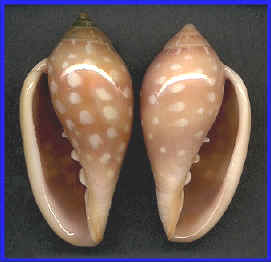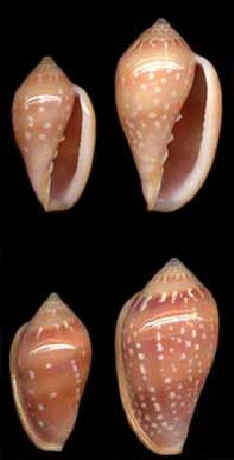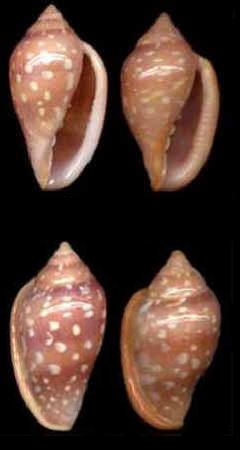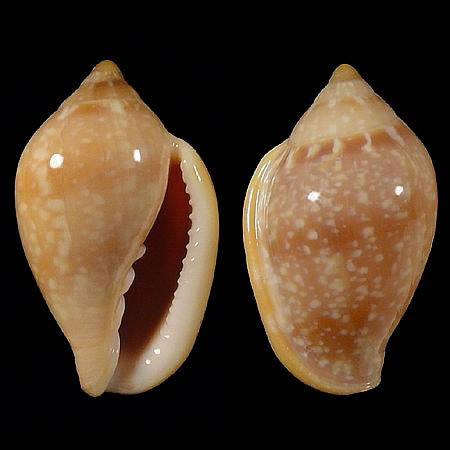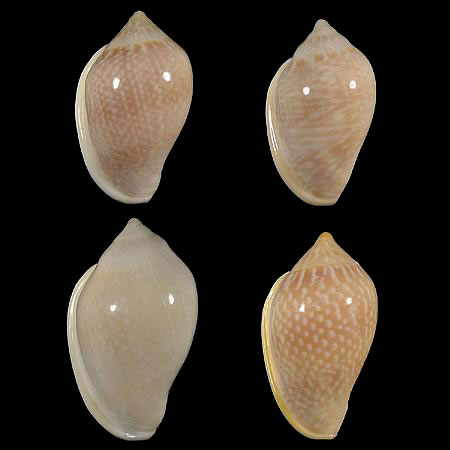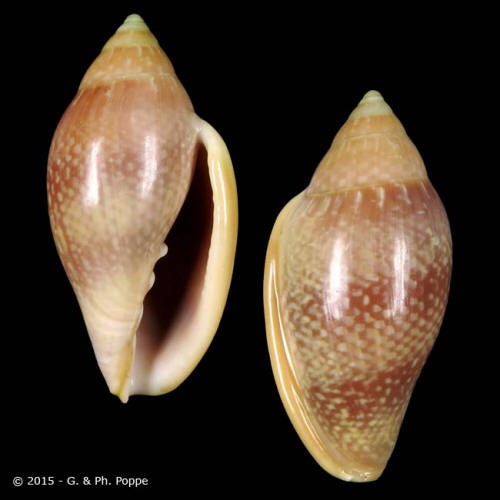Flavio
Mattavelli
Per la versione in italiano. This is an English version of the article:
Links to Marginella glabella Complex,
especially regarding the “species” Marginella pseudosebastiani Mattavelli, 2001 and Marginella (kl. ?) pseudoglabella Mattavelli,
2018, as well as the “varieties” Marginella irrorata (Menke, 1828) pseudoirrorata Mattavelli, 2017 and Marginella (kl.?) pseudoglabella lellae Mattavelli,
2017.
Preface.
The biological
categories of "species", "varieties" and "kleptons" are treated on the Species / klepton
page.
This Links page was born before 2006, as a list of links to websites
dealing with the new species M. pseudosebastiani = P.
In 2017 the discovery of M. (kl.?) pseudoglabella = L
prevailed; the page became a concentrate of references mostly to L.
See the chapter New biological category (L) in M. glabella Complex (Implications of P & S with G, inducing the
morphology of L).
The existence of the
unusually large morphs of M. (kl.?) pseudoglabella
Mattavelli, 2018 upsets the structure of the Complex of G = M. glabella Linneus, 1758-1767, which is the type species of the Marginella Genus.
This Genus is often indicated with the
abbreviation M., however often its
"species / klepton" are indicated only in
quotation marks, without indicating the Genus, thus contradicting a fundamental
taxonomic rule, to the purpose of simplification, only for my internal use.
For a maximum abbreviation, I have even used and will use a synthetic writing with specific abbreviations (see forward the list).
To this purpose consider the normal capital
letters in the same way as the capital letters in italics and / or in bold,
while I have always tried to write in italics the extended names of the species
/ klepton.
To highlight the
ambiguity of the new klepton category, sometimes I
write the term "species", and the related terms, such as their
"varieties", in quotation marks.
The original
species of Linnaeus, always considered a "true
glabella = G"
type species, must be joined to a new separate biological category, ambiguous
for science, that is, supported by either a new "sister" biological
species, or a new klepton, "specific"
category called "pseudoglabella",
recognized as a true species in 2018.
Furthermore, the
discussion could be expanded to a presumed further new "species" Marginella (kl.?) visayae Mattavelli,
2018, which, however, has not been recognized yet as a species
or a klepton, but not even defined as a simple
"variety" of an already known species / kleptons.
You can see my
first hypothesis of klepton molluscs
in the magazine Malacology World Exhibition, n ° 70, February 2011. I thank
Messrs. Cossignani of the World Exhibition of
Malacology - Cupra Marittima (http://www.malacologia.org
or http:
//www.malacologia.it ) for the publication concerning the supposed Marginella klepton pseudodesjardini (Le Béon
2008) Mattavelli 2011, today recognized as species M.
pseudodesjardini Le Béon 2012.
For the hypotheses
of klepton among the species M. pseudosebastiani, sebastiani,
glabella, desjardini, pseudodesjardini
& pseudoglabella see the page http://www.pseudospecie.it/Altriklepton.htm.
A summary was
published in the MMM-Cupra Marittima magazine, n °
74, February 2012, but this summary was revised in 2014 & 2017 on my above mentioned Internet page. The percentages, in the
conclusion of the same Web article, must however be changed again for the
introduction of the supposed M. (kl.?) visayae = V.
Fossils.
I have left out the
fossil marginellas. I report the site of Maurizio
Forli: http://www.dodoline.it/
.
This site does not
deal in marginellas, but Forli is coauthor, together
with Bruno Dell'Angelo, of Marginella
misae, fossil species of Italian Pliocene, and
not only (Bollettino Malacologico
SIM, n° 36 (5-8), 2000, pages 93-98).
M. misae is an ancestor of M. pseudosebastiani, pseudoglabella,
etc.
Marginella pseudosebastiani links.
|
|
Marginella pseudosebastiani Mattavelli 2001,
recto and verso, 64 mm length, largest sized sintype,
in Mattavelli collection (picture by Eddie Hardy,
of www.gastropods.com ). The sintypes are partially in
Mattavelli collection. The existence of the new species was perceived in 1995 and reported on
line in 2000 in the SIM site (Società Italiana di Malacologia) and in CONCH-L ( http://listserv.uga.edu/cgi-bin/wa?A0=conch-l&D=0&F=&H=0&O=T&S=&T=1). In truth this first news remained unnoticed, but
it is still in the correspective BBS archive (SIM
22/04/00) and mailing list (CONCH-L, September 2000). In June 2001 I sent a "Comparative
description" to www.seashell-collector.com (France), of David Touitou. This
description and the picture of a sintype, 47,3 mm length, remained on his Web site for 2 years. A lectotype,
55 mm length, was deposited at Museum of Malacologia Mostra Mondiale of Cupra Marittima
(Ascoli Piceno, Italy). I thank Messrs. Cossignani
of Malacologia Mostra Mondiale (http://www.malacologia.org/ or http://www.malacologia.it/) for publishing the
description of the species P, in September 2001, n°34 magazine. The species "pseudosebastiani" is notified in the Zoological Record, based on ICZN, see ION (Index to Organism Names), and WoRMS (World register of
marine species). Basic description of "pseudosebastiani" in my Statements on the Complex, with particular reference to M. sebastiani. |
Marginella pseudoglabella links.
The "species" L
was defined in 2018 (MMM magazine n °
99, April 1918, pages 29/30).
See
the definitive and comparative study also on the Web, to which I warmly refer.
The
signs of its existence date back to 2014, to the article Universo lumperia.
For precise identification of "pseudoglabella" see the Notes regarding "lamarcki cf." of Conchology Inc. Web
site, specimens which I have assumed as "pseudoglabella"
sintypes.
As
the discussion has dragged on since 2014, you will find some references to that
year and 2017, but M. pseudoglabella,
understood as a new species, should be exclusively referred
to since April 2018.
In
the article Nuovo sguardo
ai mondi di Marginella glabella e pseudoglabella
(New look at the worlds of Marginella glabella
and pseudoglabella),
dated 2017, I deepened further their correlations, also assuming that some bordeaux forms, considered in the past M. glabella forms, are instead forms of M. pseudoglabella, in most cases joung specimens.
The new "pseudoglabella"
category has not yet been recognized as an autonomous biological category (new
species or klepton), yet "pseudoglabella"
deserves to be
separated from the other species of the
Marginella glabella Complex.
The
morphs of adult and giant "pseudoglabella" are
not common, but not very rare. They are quite different from each other, but
they can be framed in the same "pseudoglabella"
population, of which I own about a dozen specimens, precisely different from
each other.
Photos of many
other "pseudoglabella"
specimens are spreaded
across the many Dealer Web sites that deal with margin shells, but with
incorrect identification names (sometimes as P, as S, as I and sometimes as G,
symbols according to the synthetic writing proposed below).
To the general links of the websites recommended below, I added the incorrect
names of the species given by the Dealers, by using the (*synthetic abbreviation
*), referred to photos that in my opinion are only of
L (whenever L is erroneously indicated with the synthetic abbreviation enclosed
in the asterisks).
Today
some L could be even confused with V, but I have not considered that, because
the identification of V is not very clear yet.
Besides
the list of links dealing with L was updated in 2017
and at the time I did not think of V existence.
Therefore in this
page I do not deal in detail with the numerous morphs of V = Marginella (kl.?) visayae Mattavelli, 2018; for which I refer to the additional page
concerning T, E, V (only in Italian language).
Links regarding the
margin species P, S, G, L & I, neglecting the
possible new "species" V.
Sometimes there is a recall cfr….(or cf….) = to be compared with …(the
name placed next to the reference).
P = Marginella pseudosebastiani Mattavelli, 2001
S = Marginella sebastiani Marche-Marchad & Rosso, 1979
G = Marginella glabella Linneus, 1758-1767
L = Marginella
(kl.?)
pseudoglabella Mattavelli, 2014? “pseudoglabella” will be published on the Web in 2017,
and in paper in 2018.
L
comprise the probable “variety” E = M. pseudoglabella lellae Mattavelli, 2018
I = Marginella
irrorata Menke ,1828.
I comprise
the probable “variety” T
= M.
irrorata pseudoirrorata Mattavelli,
2017
I notify some sites
with an excellent list of general links & marginella
pictures, although at present they could not contain pictures of all the
specimens of P, S, G, L & I.
The
identification of the marginellas is not always
correct in the auctions on line, but they are very interesting.
http://www.shellauction.net/ (Italy), big
site of Alessandro Petronzi e Claudio Pirazzini.
http://seashell-collector.com/links/page_internet-resources.html, of David Touitou.
http://www.shelldimension.com/
, Shell Directory, Sea Shell Guide of Fulvio Ferraiolo.
www.gastropods.com of
Eddie Hardy. It is a big amateur site with beautiful pictures (in
2004 > 23930 taxa, 8634 illustrated, with 18779 images). It includes the
picture of my 64 mm record sintype.
https://www.nmr-pics.nl , Rotterdam
Natural History Museum.
http://homepage2.nifty.com/bigai
(site Micro Shells BISYOGAI, Japan), of Mrs. Machiko
Yamada, with
exceptional pictures of Marginella pseudosebastiani
.
www.eumed.net/malakos
(MALAKOS, Andalucia, Spain), of Alfonso Pina,
scientific site with complete list of the Marginellidae
till now discovered
www.femorale.com.br (FEMORALE)
very good and wide Brazilian site, with a lot of
specific photos. (*P*)
http://www.deepnreef.com/ (Deep'n Reef Shells, Portugal), of Paulo Granja, an expert
and specialized site in shells of West Africa, with very fine pictures of all
species of the Marginella glabella Complex, and not
only (*cfr.P*)
www.atollseashells.com
(ATOLSEASHELLS, Portugal) of Gonçalo Rosa, another
expert and specialized site (*S, G, cfr.I*)
http://www.shellspassion.com/
(SHELLS PASSION, Mougins, France) of Philippe Quiquandon (*G*)
www.topseashells.com
of Michel Jourdan, Philippines (*G*)
http://www.conchology.be/
of Guido & Philippe Poppe, Philippines. It
contains the section Available Shells & Encyclopedia with a huge lot of
pictures of marginellas. (*G, I, "lamarcki cfr."*)
www.jaxshells.org/reverse.htm
(USA) in Harry G. Lee's section Reverse
Coiled Gastropods, devoted to left-hand shells, contains the photo of
intermediate specimens between S and P. Both specimens were
called M. sebastiani. In my opinion instead both shells should be M. pseudosebastiani,
but on the left the hybridation with S is more
evident.
|
. |
In the shell, with standard dextral worl, on
the right of the picture, the features are completely of M. pseudosebastiani.
This specimen comes from Nouakchott, Mauritania, trawled
200-300 m. You can see features more of S than of P in the shell on
the left, with worl contrary to the standard. I think that it could
be a left-hand true hybrid P X S. The outline of the shells and the outside
lips are characteristic of P, but the white spots are too big. Large
spots are characteristic of S, but, considering the single feature, that is
not discriminating. This left-hand specimen comes from Cayas
(= Kayar?), Senegal, 80-100 m (meters) depth. Data from Al Deynzer, Showcase Shells, and
Harry Lee communication. It seems that the spots get smaller as the 2 shells
move towards North Africa and move in depth, but the latitude and depth are
not significative. In both cases, the axial
white subsutural flames, which are characteristic of P, are present. This
feature is the discriminating factor
between P & S. Also see in my
photographic Quick reference guide other
usable pictures for the distinction between P & S. |
www.alboranshells.com
(ALBORAN SHELLS, Malaga, Andalucia,
Spain), of Marthe Bellocq
and Franco Gubbioli, that in 2001 pubblished very significant photos of 2P +2S, shells
with regard to the geographic distribution and the morphologic distinction
between P & S. Moreover see forward the chapter Implications of P & S with G, inducing L morphology. (*G*)
|
|
Analysis of P versus S. Left: Gubbioli referred 2 shells coming
certainly and exclusively from "Mauritania" (see my Distribution). They are "no-typical" Marginella pseudosebastiani Mattavelli 2001, 40/50 mm length. I think the photo is more coloured
than the coloration of “typical” P. The light dots on the back of the "typical" P shells are rarely aligned as in the two 40/50 mm specimens, which
tend to cross the morphology of some "lumperias",
while always they remain good P. ------------------------------------------- For the "typical pseudosebastiani”,
see the photo below on the left (taken from ALBORAN SHELL too), of a specimen
coming from Mauritania, 55mm length. On its right, another interesting photo of ALBORAN SHELL declared
"pseudosebastiani freak", from Mauritania, 42 mm. |
Right: 2 shells coming from "Guinea" of "nearly typical" Marginella sebastiani Marche-Marchad &
Rosso 1979, 56/54 mm length. The coloration
could be typical of the sebastiani morphology,
but there are also less coloured S. In fact, on the bottom right, a photo of another almost typical
ALBORAN SHELL specimen, Marginella sebastiani, 53 mm length, from Guinea. M. sebastiani also has
considerable variability (see Guide), while the primacy of variability belongs to M. glabella. In the group S,
P, G, L the intermediate forms are very numerous, but without assuming that
the complex could be a single superspecies/superklepton. |
|
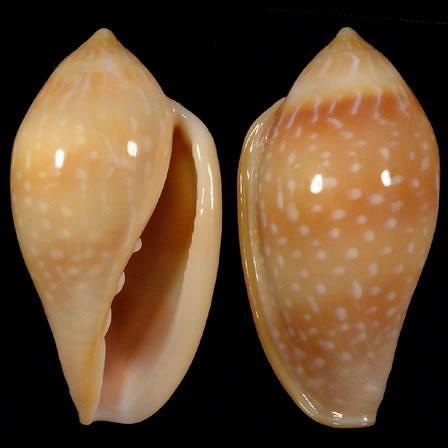
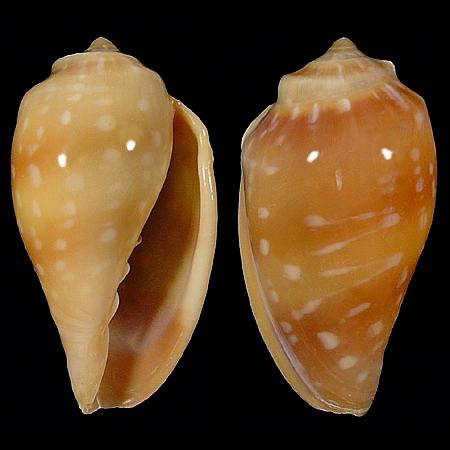
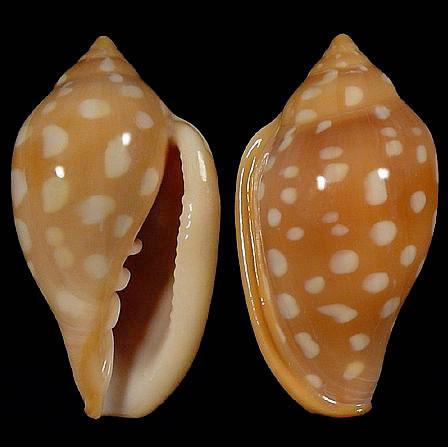
In the previous 3
photos and in all the following ones, I have tried to keep the lengths of the
shells in a ratio of scale, comparing one another.
New biological category (L) in M. glabella Complex.
Implications of P & S with G,
inducing the morphology of L.
|
Above,
note the mixed pitting of an "almost typical" M. glabella Linnaeus = G, West Sahara, 34 mm long
(photo from the ALBORAN SHELLS website). Note
also the difference between the slopes of the shoulder, under the suture of
the last turn: towards the apex the slope is greater
than towards the head of the mollusc. The head is at the bottom in the photo. The
opening is elongated towards the head of the shell.
The apex has a fairly open cusp angle, about 80
degrees. |
The morphological
differences are evident comparing G to the almost typical P & S, and it
would seem so also for 4 other shells, proposed as G in ALBORAN SHELLS, see
photo on the right, West Sahara, from 33 to 39 mm length. G is such a variable species
that it is very difficult to typify (the first 2 could be “almost
typical G”; the third, at the left bottom, could be a leucistic form, definable G albida). In the case of the fourth
specimen, at the right bottom, I disagree with the ALBORAN SHELLS site. In
the past, many varieties that I thought come together in G, now I believe
that they could be separated, because of a real
biological difference. In July 2017 I had called
only the fourth morpho in the lower right "pseudoglabella",
morpho intended as a separate biological category,
but unfortunately confusable with an atypical G, and also especially with P,
less with S and with I (and perhaps confusable with V, or better with the
true L, in variety E). Today, due to the differently
angled shoulder of the shell, more leaning towards the apex (as in true G), it would be better to define this specimen "pseudoglabella cfr.” (or “E cfr.”? Or a true hybrid?), about
36 mm length. The specimen of "pseudoglabella cfr." appears
to me more elongated than the other G and with the edge of the mouth more
elongated than that of the other 3 shells considered true G. |
My doubts will be
confronted on the page “visayae”, Fig. 2. |
Intuition
of the existence of "pseudoglabella"
= L
The Complex is apparently almost
inextricable with regards to the biological belonging of the single morphs, while
different morphological typologies can be distinguished, sometimes with
difficulty, as for example "pseudoglabella cfr.".
For me "pseudoglabella" means a series
of morphs difficult to typify, however belonging to a new and highly variable
"species".
The light
dots are mostly a little screened, as in the case of the specimen "pseudoglabella
cfr." mentioned above, with the dots
regularly all separated from each other, but in other specimens, which then I
will declare syntypical, the dots are often knead,
making the chaotic screening, see next Note regarding the "lamarcki cfr."
of the Conchology Inc. Web site,
then declared true L.
The average total shell stretches of L (mean stretch = 1.91) can become like that of P (= 1.96) &
S (= 1.83), or rather we say that it is on average an intermediate stretch
between S & P, with the mouth of L slightly more elongated than that of G,
which has a shape with an average total stretch of 1.69.
The shell of L can sometimes be less
elongated than S & P, so that it can be mistaken with M. glabella.
There are morphs of L that are often
elongated as S and almost always have the shell shape
of P, e.g. photo immediately below right, specimen 52.5 mm long, with
morphological characteristics to deserve the qualification of E, which will
then be understood as a variety of L on the "visayae" page.
Next we will see that the specimens ex "lamarcki cfr." of Conchology, Inc., which for me will be
made typical of L, actually have the apical loop slightly more elongated than
apical loop of the specimen 52.5 mm long.
The resemblance of L with G in the
majority of cases is strong, but the pitting and sometimes the elongation can
cross the morphology of P, without appearing exactly P (and not even appearing
S, which instead it has much larger and less numerous light dots).
The typology of the L dots, precisely
in the "variety" E, also recalls those of Marginella irrorata = I var. pseudoirrorata = T, as in the same photo immediately
below right, specimen of 23.5 mm.
I would not exclude for L the
possibility of multiple hybridization G, P, S, perhaps hybridogenetic
(to say klepton).
There may even be links with the
biology of Marginella irrorata pseudoirrorata.
Therefore the
doubtful identification of L appears to me contradictory, and in fact sometimes
L is indicated in some of the abovementioned links (and in other sources) with
the wrong names of S or P or G or even M.
irrorata gigas, apart
the wrong identification with the "lamarcki cfr:" of the
following Note regarding "lamarcki cfr." of the
Conchology Inc. Web site.
Here are some photos, in addition to
the numerous photos of "varieties" that are candidates to be L. These
"varieties" had appeared in the discussion on the Universo lumperia
page, starting from picture Fig. 00, in 2014 already supposed to be
probable L.
Marginella glabella
cfr. 38
mm, with separated dots

 Marginella pseudoglabella
cfr. (var. lellae
= E), 52,5
mm.
Marginella pseudoglabella
cfr. (var. lellae
= E), 52,5
mm.

 M.
irrorata (var. pseudoirrorata
= T) 23,5 mm.
M.
irrorata (var. pseudoirrorata
= T) 23,5 mm.
The "ideally typical pseudoglabella"
could be placed in the middle between the left 38 mm and the central one 52.5
mm in shell length, however a typical L will be syntypicized
in the ex "lamarcki cfr." of
the Conchology Inc. site, therefore the 52.5 mm specimen (= E) is a morph to be compared with L.
You can think that on the left (38
mm) there is yet another variety of G (which is probably exact, but note that I
wrote G cfr.) and on its right there is a variety of
P, or one of S with small and numerous dots, or still a large giant G. All
these 3 identifications appear wrong to me, regarding the 52.5 mm specimen,
which would instead deserve a specific separation as new “variety of species” =
E, to be compared with a typical new “species” = L.
In the case of the large 52.5 mm
shell, the subsutural flammules are not typical of P,
the dots are too small and numerous to be of an S and its total elongation
(1.78) is not from G, while the mouth elongation (1.28) falls oddly into the
mouth elongations of the G.
The clear subsutural flammulas of a syntipic L (see forward ex "lamarcki cfr." of the Conchology Inc. site)
are relatively scarce in number compared to those of P, but in the specimen
called E (52.5 mm) some flammulas widen in speckles,
as sometimes it happens in some rare cases of S, where however flammulas are usually almost always absent.
Note that the flammulas
of this E are more enlarged than those of the "pseudoglabella
cfr" 36 mm long, the fourth morph of the
previous photo.
Incidentally, I know that the whitish
flammules of a typical P are lean and slender, fairly dense in number, always present under the suture, in
fact the subsutural flammules are a discriminating
factor for the identification of the species P.
Indeed, the flammulas
of L sometimes resemble those of G, where they are always present, but I would
not say that they are always the same as those of G.
The presence of flammules
is common to P, G & L, therefore alone it is not a clear element of
distinction, except mostly for the distinction from the typical S, which
however also presents a considerable variability.
Hybrids
P X G X S?
 45 mm, Mauritania, perhaps PXS
45 mm, Mauritania, perhaps PXS
 47,8
mm, Mauritania,
perhaps GXS
47,8
mm, Mauritania,
perhaps GXS  37,3 mm,
Senegal, perhaps
PXG ? #
37,3 mm,
Senegal, perhaps
PXG ? #
# I remember
that in 2005 I had called "antinea"
some then believed varieties of G, but in 2011 I hypothesized that the "antinea"
could actually be klepton PXG. The light dots of the
livery of the 37.3 mm shell are more distinct than those of other "antinea", to
the point that the 37.3 mm shell could be a "not antinea",
neither variety 2005, nor klepton 2011, but be a
variety of the new category L, better to say "L cfr.", or it could be an occasional
hybrid.
The morphologies to be compared with L could form a new multiformed biological category, very dispersed in single
varieties, or it could be a bunch of very atypical varieties each of the other
species, if not a bunch of more or less hybridogenetic
hybrids, even in multiple hybridation.
Could the 3 images above be of 3 different
hybrids? or all of variable forms of the same
"species" L?
Of course, the specimens are not typical forms of P, S or typical G. But they are neither certain forms of L.
All the 3 above specimens could be forms of a multiklepton P X G X S, with the parent species still to be
identified by exclusively genetic analysis, as their morphology is confusing.
"pseudoglabella
= L" with
percentage numerical ratios.
The specimens that I know of the species/klepton L are not very homogeneous one another.
In other Web sites you can
find photos of splendid dark forms declared varieties of G and forms declared
varieties of S with numerous small dots, at the extreme limits of the variable
morphologies of L.
I would instead consider these as extreme varieties
belonging to L.
In particular for the dark forms of G it is necessary to
distinguish:
• if they are precisely forms of the species G, as so
far almost universally declared by the majority of the Web sites, or rather if
they are forms of the new species L, which would thus enclose a specific slice
of the morphology universally attributed entirely to G.
• if, on the other hand, they are precisely forms of
L, since there are many intermediate varieties between L in relation to S and
G, it is necessary to evaluate the presence of any possible klepton
L X S and L X G.
In fact, if L is a species, it could hybridize with neighboring species, not excluding LX P too. In my photos
above, the 52.5 mm long specimen may be a hybrid LX P?
Morphologically we will never know for sure, however I suppose that it may be
an unhybridized variety of L, for the existence of
similar specimens.
Actually my assumptions are simply based on the sight
of only about a dozen presumed L in my possession, plus about twenty specimens
valued L, in photos from different sources (Web Dealers) and therefore
presumably from different geographic origins.
Till
now I did not consider a further thirty ex "lamarcki cfr." shells,
proposed by Conchology, Inc. Web site, for which see the following Note
regarding them.
There is absolutely no connection between the real
species Marginella lamarcki
Boyer, 2004 and L.
Do not call "lamarcki cfr."
those morphs that seem to be "L cfr. = pseudoglabella cfr.". Any reference of L to "lamarcki" Boyer is misleading. However I will have to use the name of “lamarcki cfr.”, to correct it, when
referred to L.
Similar considerations can be made in the estimable cases L X I, in particular E X T,
including the 23.5 mm long specimen T photographed above, morphologically
considered as a syntype, together with the 21.5 mm
specimen, of the "pseudoirrorata"
variety of the species M. irrorata.
Let's
consider the number of specimens, which can be merged into a single group, in
order to classify it with respect to the total number of all specimens of other
similar groups of the whole Complex, that is with respect to all those
specimens recognized as belonging to different species of the same Complex. The
aim is to obtain frequency percentages of the single species, as already
considered in the article "Other kleptons in the Marginella glabella Complex?".
In this article 2017, thinking
of L = (G X S), indeed mixed with (G X P) "not antinea", adding the
dark forms ex G, considered L and having also included the ex "lamarcki cfr.", which can be linked by colouring to the
dark forms, I wrote (in magenta at the bottom of that page) a presence of L in
about 8% of the total Complex. In 2020, I believe
that 8% could be an estimate that is a little overwhelming, but still
plausible.
A much lower percentage (<2
%?) in general would push towards the hypothesis of possible sterile hybridizations,
or alternatively, and in particular in the "specific" case of L, to
the hypothesis of a new very rare category. I discard as a further alternative
the belonging of the various dissimilar specimens of L each to already known
species of the Complex, in different atypical varieties.
These are all inferences to be
verified through a greater number of specimens, and better with genetic analyzes, which, however, could even lead to a general
biological unification of the whole Complex, which is highly questionable.
From a purely collecting point of view, L remained a
very rare "species" for me, until I discovered the former "lamarcki cfr." of
Conchology Inc. Web site. Their existence lowers the level of rarity, but L is
still a fairly rare "species".
Note regarding "lamarcki cfr." of
Conchology Inc. Web site.
The same site
subsequently recognized the new "pseudoglabella" species and so has now changed the
names of the ex "lamarcki
cfr.", which however are
still referred to below as such, being the original text written in 2017 (and
in 2020 left substantially almost unchanged).
|
1) the “lamarcky cfr.” of Conchology Inc. are almost like my L, as introduced in 2014/2017. 2) in the case of elongated
forms of L, the presence of L in Senegal is confirmed in a considerable
number of specimens. The number of specimens of suppositories L known to me
previously was about twenty, therefore the total would rise to about 50, a
significant number, which would make the hypothesis of possible sterile hybrids
discarded. The new "species" L remains however quite rare, compared
to the frequency of the species G, I, P, S. 3) if these are not L forms, they are almost thirty
specimens very different from the comparable species already known of the Complex,
to suspect the presence of a new biological category (klepton
or species), excluding the hypothesis of occasional hybrids and excluding
that the specimens in question are hypothetical atypical varieties of already
known species. 4) the length of the shells
from Conchology, Inc. varies from about 46 mm, up to 68.8 mm of the
photographed specimen beside. On average they are
between 51/60 mm long, a considerable length for the Complex, to be
positioned among the largest species. 5) unlike my specimens
previously considered L, the light dots in their livery are sometimes mixed,
and the elongation of the profile of the Conchology Inc. shells is also more
acute than that of my specimens. In summary, it is probable that these are very
elongated varieties of L. I have assumed the thirty homogeneous
specimens of the photos of Conchology, Inc. as syntypes
of L, intended as a new species L. Some "pseudoglabella" I proposed in my previous photos
could actually be hybrids between this new M. pseudoglabella and some other nearby
species (P, G, S, I), or simply atypical varieties of M. pseudoglabella new “species”. |
For details, please refer to the article Nuovo sguardo ai mondi di Marginella glabella e pseudoglabella,
2017 or Descrizione
comparativa di Marginella (Kl.?) pseudoglabella Mattavelli,
2018 nuova "specie" (articles only in Italian).
Having transferred the same name L = Marginella (kl.?) pseudoglabella
Mattavelli 2014 to all thirty specimens photographed
by Conchology Inc., in 2017 I invalidated the year of my 2014 declaration, made
on the Universo lumperia
page.
In addition, as the paper description was made in April 2018, MMM magazine n° 99, the year 2017 is
invalidated too.
The new "species" could be
roughly divided into 2 subspecies or subkleptons,
of which the specimens of Conchology, Inc. would represent the subspecies or a subklepton typical of Senegal, and some of my specimens of
L (some of which may perhaps be hybrids) could represent an atypical subspecies
or an atypical subklepton of Mauritania.
However, there is Marginella (kl.?) pseudoglabella
new biological category, distributed from Mauritania to Senegal, with greater
frequency and liveliness in Senegal. I do not exclude that the geographical
range could be wider, perhaps with further local subspecies or subkleptons in other geographical areas of West Africa,
even if not adjacent to Senegal and / or Mauritania.
For the new category L I
think that the hypothesis klepton is more probable,
rather than the hypothesis species, given the reinvigoration of the large
specimens of Conchology, Inc. and the rather low percentage of presence of L,
in relation to the percentages of the other true species of the Complex.
Deepening on the
homogeneity of the characteristics of L.
My Ls, apart from the ex "lamarcki cfr."
above, are not all homogeneous as the P or S or G or "typical" I,
which appear well grouped individually and precisely they form homogeneous
groups of similar individuals. These can be subdivided into subgroups (atypical
varieties ) of individuals also similar to each other,
but slightly less similar to the nucleus of the "typical" subgroup,
however varieties comparable in similarity to a well homogeneous
"typical" nucleus.
Within the group of my L
there is no clear homogeneity of nucleus and all individuals appear each with
its own individuality, scarcely similar to the other individualities of the
group, except for some ideally typical morphological characteristics, which
could agglomerate all individuals in L. However these
characteristics can scarcely be found all exactly and simultaneously in the
same individual.
Instead
the thirty specimens of ex "lamarcki cfr." of
Conchology, Inc. are largely all homogeneous: this is the reason making me
choose a possible L holotype among those specimens. Among my L, the specimen
most similar to those of Conchology, Inc. is the one photographed above 52.5
mm, coming from Senegal, Gorée bay, depth about 10 m.
I propose that as a future lectotype, if a holotype is not designated among those syntypes.
In fact, I believe that the majority of the Conchology, Inc. syntypes (= L) were only photographed on their website (Shell Encyclopedia), but they are
no longer materially available, since they are scattered among various
collectors.
I recall below the ideal characteristics of my
first idea of L, found partly in this lectotype:
·
small and variable dots from retiform to chaotic, always separated one another (what is
questionable for the syntypes of the group ex "lamarcki cfr.");
dots sometimes larger (e.g. LXS cases),
·
total elongation (mean stretch
= 1.91) variable from the typical stretch of S to that of P; average mouth
stretch variable slightly beyond the typical elongation of G (but below average
in the lectotype, where the mouth stretch is like in the
majority of G),
·
subsutural flammulas
from those typical of G to those of P, generally scarcer in number (but the
whitish flammules can sometimes be better
distinguished, since they can appear in spare, short and wide spots, as in some
gerontic S, although the flammules
of L are usually thin and slightly slender, precisely between G & P),
·
usually brick background color such as S, average dimensions between those of giant
G and those of the largest P, denticulation of the margin variable from poor
(as in the lectotype) sometimes medium (like that of
some adult G).
Some ideal characteristics of
L must be corrected by the knowledge of the aforementioned specimens of the ex
"lamarcki cfr.", syntipic of L: very large dimensions in Senegal (even
larger than the average dimensions of P), light dots sometimes mixed, that is,
not always separated one another; average mouth stretch of L almost always
about 1.36, compared to about 1.31 average mouth stretch of G.
The dots, sometimes mixed, are
the most dubious morphological characteristic, perhaps useful for a sub
specific distinction between the specimens of Senegal (where the GXS hybridogenesis could prevail, with dots sometimes mixed
towards G and sometimes distinct towards S), and the specimens of the
Mauritania (where it could be GXP, with dots sometimes mixed towards G and
sometimes distinct towards P). On the border
between Mauritania and Senegal, there could be an SXP hybridogenesis
or there could be real sterile hybrids (with dots sometimes separated or
sometimes kneaded, according to the hybridizing couple). I consider the
kneading as a prevalent characteristic of a hypothetical tendency to G, if L is
understood as klepton, or the kneading as a variable characteristic of L, if
instead L is understood as an authentic biological species.
Despite the inhomogeneity of
some individuals of L, in my opinion, they, individually considered, cannot
be morphologically assigned to any of the nearby already known species of the
Complex (P, S, G, I): that makes me opt for the probable existence of L as
a new multiform biological category, due to the relatively high number of found
specimens (apart from the hypothesis of possible sterile occasional
hybridizations for very rare specimens).
L is a bit like the Comacchio
bridge, with branches in several directions: in the
case of L there are the directions P, S, G, I with attraction and at the same
time repulsion to and from the adjacent nuclei of the species.
You can also think of directions not lying in the same
plane, in a spatial view of the whole: L can be placed
in the center of an imaginary tetrahedron.
It is as if the virtual nucleus of L was quartered
according to the 4 morphological directions mentioned.
I do not know if that happens in the pulverization phase of a large original
compact nucleus or in the aggregation phase towards a new biological category;
I don't want to discuss biological evolutionism.
Perhaps L is widely
dispersed geographically from West Sahara to southern Guinea. I could be more
precise about biology if I knew a greater number of specimens and all the
places of origin of the various L, but unfortunately L
is quite rare on the collector's market. This does not mean that L subforms are rare in nature, somewhere in West Africa. Indeed
I believe that somewhere they are temporarily almost common (eg Senegal for the ex "lamarcky cfr." of Conchology Inc.).
Flavio Mattavelli
Links page release, limited to links references only
to Marginella pseudosebastiani,
preceding the 2006.
Integration with news on "pseudoglabella" and
announcement of Marginella (kl.?) pseudoglabella new species, update September 2017.
Remake of this page, July 2020:
Page top only in
English language.
Same page only in Italian language.
Post
Scriptum.
In 2021 Marginella (kl.?)
visayae Mattavelli
was described, but there is only a mild reference to this in this article,
since the " species visayae" was already supposed in 2018.
I do not deny that I find myself in
taxonomic difficulty, faced with such amazing morphological variability.
The site is
divided into 4 Sections (Shells, Machines, Aeromodelling,
Gorgonzola),
for a total of 53 pages in 2023.
All pages
are also accessible from the general index.
The
individual sectional pages are accessible by linking the Homes of the
individual Sections:
·
Machinery
Section (8 pages, some
in English) with references to the Machines
built by the Cavalleri Mattavelli
Sas Company.
·
Model
Aircraft Section (18 pages only in
Italian: Aeromodellismo).
·
Gorgonzola
Section (2 pages, only
in Italian). Long monograph on "My
Gorgonzola after 1990", miscellany with origins of the city and the
homonymous cheese, supplemented by some chatter from a conchologist.
·
Shells Section.
Green in English, a list of 24 sectional pages (including this
one), regarding Shells Section only.
- Introduction
(only in Italian language) and the Shells Section start page.
- Specie/klepton Concepts, 2016 update.
- Marginella pseudosebastiani Mattavelli, 2001, versus M. sebastiani & glabella Complex, 2006 archives
- Atlante delle specie attuali
del Marginella glabella
Complex e di alcuni loro ibridi morfologici, 2022. Italian Atlante
(ex Guida) di identificazione
fotografica regarding all current species
of the Marginella glabella Complex
& their morphologic hybrids, with shell spots resumptive
drawing & notes (Italian only).
- Marginella glabella & sebastiani Complex Atlas (ex Quick reference guide). 2022. Pictures of Marginella sebastiani, desjardini, pseudosebastiani, pseudodesjardini, goodalli, glabella, irrorata, pseudoglabella, velai, visayae & some morphologic hybrids (English only).
- Analysis of 5 confondibili marginelle simil-glabella. Release 18/02/2021.
- “La variabilità
fatta specie” article, part 1, to be revised, regarding M. glabella & irrorata.
- “La variabilità fatta specie” article, part 2, to be revised, regarding M. glabella mutabilis.
- “La variabilità fatta specie” article, part 3, to be revised, regarding M. glabella antinea.
- Other kleptons in the Marginella
glabella Complex? With photografic table. 2021 update.
- Marginella pseudodesjardini Le Béon, 2012 new species. Notes on the different "pseudodesjardini giselica" Mattavelli, 2013 form.
- Universo lumperia. Morphologic hybrids SXP and SXG. Possibility of the new M. (kl.?) pseudoglabella Mattavelli, 2014 hypothesis.
- “pseudoirrorata” 2017, variety of Marginella irrorata.
- Complex links. 2020 remake. Hypothesis of “pseudoglabella”, 2018 new species.
- Links solo in italiano con postilla “La bocca della verità”. Release 2020.
- Nuovo sguardo ai mondi di M. glabella e M. (kl.?) pseudoglabella, this is supposed new species or klepton in 2017
- Descrizione comparativa di Marginella (kl.?) pseudoglabella Mattavelli, 2018 nuova "specie"
- Marginella
(Kl.?) visayae Mattavelli, 2018, supposed new “species” or klepton, with description of the “varieties” M. pseudoglabella lellae
& M. irrorata pseudoirrorata.
- Marginella
(kl.?) visayae Mattavelli,
2021 new species, “sibling species” of M. glabella & M. irrorata.
- M. glabella Revision, with proposals of my new denominations of its varieties (M. glabella glabella & M. glabella neoglabella). 2021.
- "Albinism"
of the species similar to M.
glabella & M. irrorata, with hypotheses, only on
Internet, of 2 new "albino species" (M. albida
& M. tizianica),
November 2021.
- "Albinism" in
general, even for species not belonging to the M. glabella & sebastiani Complex. 2021.
- Un salto nei retini conchigliari “ghepardici”.
- Marginella
sebastiani nelle
sue 5 varietà principali.

